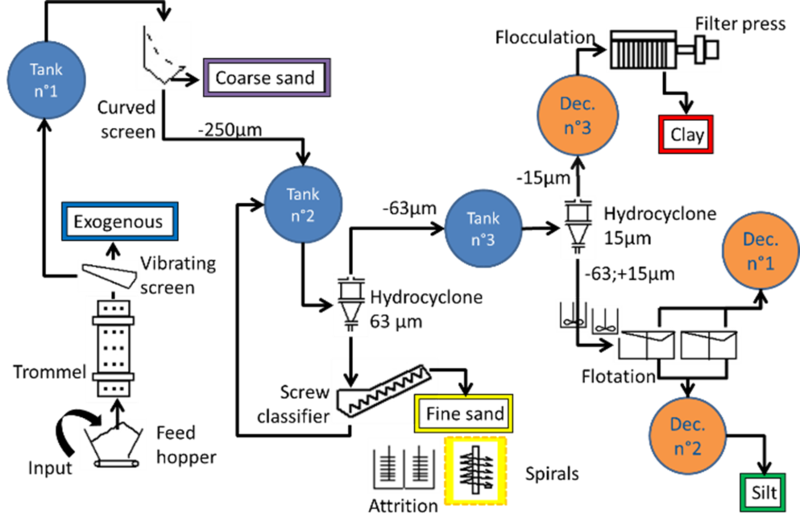Experimental pilot platform for the treatment of dredged sediments
|
SOLINDUS ERDF had the aims to find a solution to reduce the volume of Walloon dredged (river) sediments to be landfilled. The final goal was to prove that size classification can isolate pollutants inside the fine fraction. The other fractions are sufficiently clean to be valorised. In many cases, wet techniques are more suitable to treat river sediments, even if a more advanced separation is required. This has been demonstrated through a pilot station, running about 1 ton per hour. The separation included few steps: 1) anthropogenic and coarse materials removal by using scrubbing trommel and vibrating screens; 2) after buffering storages, coarse sand (2 mm to 250 µm) through a curved grid; 3) fine sand (250 to 63 µm) through hydrocyclones followed by a screw classifier 4) Silt (63 to 15 µm) from clay and fine silt (under 15 µm) through 2 parallel finer hydrocyclones. The last silt separation is innovative, as it cannot be found in industrial plant or demonstrators. After separations, clay and silt are recovered from water suspensions. Clay fraction is recovered by decanting with flocculants and filter pressing. Silt fraction is recovered using filtrating big bags.These separations concentrate the heavy metal pollution in the finest fraction (approximately 40%). Sand fractions (10-20%) can be valorized as sand. About 40% of the sediment (mainly between 63 and 15 µm) can be used as non-polluted sediment (mainly as embankment), in terms of pollutants levels (heavy metals and organic pollutants). The main challenge is constituted by the quality of the sand fractions and non-polluted sediment fraction. These have to be sufficiently clean to valorize them. Sand fractions can be washed using attrition and spiral techniques. Froth flotation techniques can be applied to remove some heavy metals present as pollutants in the silt fraction (between 63 and 15 µm).The water used in the platform circulates in closed loop, allowing saving water resources. The experimental platform is now available for industrial tests or for projects. An economic study for a 100,000 tons/year (dry matter) plant was made in 2010, with the assumptions of building it in Wallonia and with this distribution, typical of river sediments: 18% as sand, 40% as non-polluted sediment and 42% as sediment to be landfilled. For an investment of 7.3 M€, operational costs were 2.9 M€/year, giving a cost of 29 €/ton. |
Graphical information:
 |
 |
 |
References/web links
- Fernando Pereira, Etienne Koller, Christian Lucion, Jean-Michel Hiver, Yves Libert, Integrated and sustainable solutions for the treatment and valorisation of dredging sediment: the "SOLINDUS" project, PIANC 32nd congress, Liverpool (2010) 1-7
- Hervé Brequel, Alex Iwaszko, Christian Lucion, Dragage et traitement des sédiments – La plateforme expérimentale Solindus, Recyclage & Valorisation, 36 (2012) 60-65
- Pereira F., Koller M-M. and Lucion Chr, Mineral processing approach for the decontamination of dredging sediments from Walloon canals, I2SM Casablanca (2010)
- https://www.youtube.com/watch?v=CKzF6ThGw6g
- https://www.issep.be/solindus/
- https://www.enmieux.be/projet/solindus-solutions-integrees-et-durables-pour-sediments-et-matieres-assimilees
- https://www.ctp.be/files/pdf-liens/ctp-fiche-1-solindus.pdf
- https://www.environnement-magazine.fr/cleantech/article/2012/10/08/34408/solindus-veut-valoriser-les-sediments-dragage